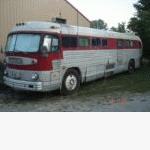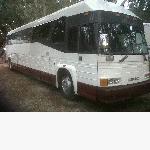| Author | Message | ||
| Steven Foster (57_gmc)
Registered Member Username: 57_gmc Post Number: 38 Registered: 12-2010 Posted From: 72.156.216.251  Rating: N/A |
I have a AC Delco on my 6-71 belt drive (2). OK I have the main output going to starter batteries. Now there is (2) field terminals. I think one should be ground and the other one is the bus voltage which will tell the Alt how much charge it needs. The way they got it wired up is one side of the field has a wire going to the output and the other side has a wire that is on the bus voltage.. This to me will not work right.. I have the big main shut off in the battery compartment, and I could alway leave it on and have no problems. Now if I dont cut it off the batteries will be dead overnite or will not have enought to start. | ||
| marvin pack (Gomer)
Registered Member Username: Gomer Post Number: 1268 Registered: 3-2007 Posted From: 71.55.183.81  Rating: N/A |
Steve,Can you get a picture or a model of the alternator? That will clarify what to do. I have one on my 04 and it has a main cable to the batteries,one is ground. gomer | ||
| Sean Welsh (Sean)
Registered Member Username: Sean Post Number: 1239 Registered: 1-2003 Posted From: 72.171.0.142  Rating: |
No, if you have a Delco with two field terminals, one of them goes to the regulator, not "bus voltage." The regulator can be one of two types, a P-type or an N-type (also called "B" regulation and "A" regulation). One style regulates on the positive side, and the other type regulates on the ground side.
If you have a negative-type regulator, then one of the field wires will, indeed, be connected directly to the output terminal just as you describe. My Neoplan has this style, for example. If you have a positive-regulating type, then one field terminal will go to the regulator and the other will go directly to ground. . The regulator is what tells the alternator how much charge is needed. You need to know what model of regulator you have before we can tell you whether your field wiring is correct. Don't change it without knowing -- you can blow the regulator or fry the alternator if you get it wrong. -Sean http://OurOdyssey.BlogSpot.com | ||
| Steven Foster (57_gmc)
Registered Member Username: 57_gmc Post Number: 39 Registered: 12-2010 Posted From: 72.156.216.251  Rating: N/A |
Sorry it told me so long to get back, been out of town. The number on the Alt is 1101050 and is is 12 volt Neg Ground 100 amps. Has one output terminal and 2 field terminal. Has the built in Reg. The way they have it wired up is there is a jumper running from the output over to one of the field terminals and then when you turn the switch on it puts bus voltage to the other field terminal. I thought it was wired up before the shop was output went straight to the batteries and bus voltage when to one field side and the other field side when to ground. I will watch for any ideals on how to wire it up as if I dont cut the main off in batteries box they will be down next day. Thanks Steve | ||
| George M. Todd (George_todd)
Registered Member Username: George_todd Post Number: 1193 Registered: 8-2006 Posted From: 99.172.182.105 Rating: N/A |
Steve, A search doesn't show a wiring diagram. However, from what you describe, I don't feel it should have a wire connected to the output, which is hot all the time. Voltage on both field terminals won't give you any field current flow, so you won't get any output. I'm also having some trouble with your saying it has two field terminals, and a built in regulator. Sean has described the two types of alternators requiring a regulator, and what that amounts to is that one regulates the field current before it gets to the winding, then the other end of the winding is grounded. The other type has voltage applied to one field terminal, and regulates the flow as it comes out of the other terminal. Two field terminals, no separate regulator, no overcharging, ? Try removing the wire from the output to the field terminal and see if it still charges, and doesn't go dead overnight. You can check this quickly by removing the wire from the output, careful not to touch anything, replace the output lug and nut, then touch the field wire to the output cable. If you get a little spark, you have found one of your culprits. Good luck, G | ||
| Dal Farnworth (Dallas)
Registered Member Username: Dallas Post Number: 439 Registered: 7-2004 Posted From: 75.91.197.166  Rating: N/A |
Delco 1101050 is a one wire internally regulated 10SI alternator. http://www.spidermarine.com/showitem.aspx?&id=104266&name=100%25%20NEW%20Delco%20%2012%20V olt%20100%20Amp%20Alternator It wires like just about any standard GM alternator in automotive use from the 70's and 80's http://cgi.ebay.com/ebaymotors/Delco-Remy-Alternator-1101050-100-Amp-12-Volt-_W0QQcmdZView ItemQQhashZitem4aa600e8dfQQitemZ320612657375QQptZVintageQ5fCarQ5fTruckQ5fPartsQ5fAccessori es | ||
| Sean Welsh (Sean)
Registered Member Username: Sean Post Number: 1241 Registered: 1-2003 Posted From: 67.142.130.37  Rating: |
OK, now I know what we are dealing with. You confused me by saying the alternator has two field terminals, which is not correct. The Delco 10SI, which is what you have, is a "3-wire" alternator. One terminal is the main output terminal, which you have clearly identified. The other two terminals should be labeled "1" and "2". The "1" terminal goes to a dash warning lamp. It provides ground for the lamp circuit if the internal regulator detects a problem. The voltage provided through the lamp also provides the initial field excitation for start-up. The "2" terminal is the battery sense terminal for the regulator. This is normally connected to battery positive. In some applications, it might be connected via the ignition switch, but for simplicity it is commonly bridged directly to the main output, as you have observed. (Since this is what is governing the regulated voltage, it is really better to connect it to the battery directly if possible.) I would say your alternator is wired correctly. If you are observing battery voltage on the wire to the #1 terminal, that's because it is being provided through the lamp circuit which is as it should be. The terminal only drops to ground when the alternator/regulator is having a problem, so a voltmeter will show +12v there coming back from the indicator lamp under normal circumstances. Internally it is connected to the half-wave rectified output of the diode trio, which also supplies the excitation voltage to the internal regulator when the alternator is spinning. If you turn the ignition key to "ON" but do not start the engine, your warning lamp should come on, and the voltage measured at the "1" terminal should show close to zero. Some technicians may install a dropping resistor or diode instead of a dash lamp to supply initial excitation to terminal 1, particularly if running a wire all the way to the dash is inconvenient. I would expect to see this only in a retrofit. However, it is very important that the voltage supplying this component come from a switched source that is only hot when the ignition is on, otherwise current will be constantly flowing to ground through the regulator when the alternator is not turning, draining the battery. HTH, -Sean http://OurOdyssey.BlogSpot.com (Message edited by Sean on March 13, 2011) | ||
| Dal Farnworth (Dallas)
Registered Member Username: Dallas Post Number: 440 Registered: 7-2004 Posted From: 75.91.197.166  Rating: N/A |
Oops, yup, I was mistaken.... old age I think... 3 wire alternator. I knew that! I did! I have no idea why I typed one wire and was thinking three wire. | ||
| George Martinez (Foohorse)
Registered Member Username: Foohorse Post Number: 410 Registered: 1-2010 Posted From: 72.211.128.245  Rating: N/A |
Pot.....tery is a relaxing stress relieving hobby that may help your memory. I find it is rampant here in AZ | ||
| Steven Foster (57_gmc)
Registered Member Username: 57_gmc Post Number: 40 Registered: 12-2010 Posted From: 72.156.216.251  Rating: N/A |
Thanks to Sean, Gomer and Dallas. My problem was they had it wire hot all the time from the output to #1 and had the bus voltage which is only hot with switch on going to #2. Now I got it with bus voltage with switch on only to #2 and #1 is open as I do not have a light up front. Batteries are not running down I just have to check and see if Alt is charging now. What should I look for at batteries 14.5 or so ?? Again Thanks for the help Steve | ||
| Sean Welsh (Sean)
Registered Member Username: Sean Post Number: 1242 Registered: 1-2003 Posted From: 67.142.130.18  Rating: N/A |
OK, wait a sec. You really don't want to leave #1 open because that's where the alternator gets its initial field excitation from. It is not strictly necessary, as once the alternator gets up to full speed, it will most likely start charging anyway from residual magnetism. However, it is really better for your charging system to connect it correctly. Because of the way this terminal is wired inside the alternator, you should not just connect it to straight battery voltage. You really need to have the lamp there, or else a resistor or diode instead. Just make sure that the lamp, resistor, or diode is fed from a circuit that is only energized when the ignition is on. On the #2 post, it is not important that it be connected to a switched circuit. It would be fine connected directly to the alternator's battery output terminal, but connecting it to the battery directly is best. Connecting it where you have it, downstream of the ignition switch, means it will read voltage after more of a drop than at the batteries. This is probably fine so long as the voltage at the batteries does not read too high.
Depends on the batteries, but generally 14 is considered a safe charge voltage. I would not want to see anything higher than that on a single-stage charger. -Sean http://OurOdyssey.BlogSpot.com (Message edited by Sean on March 14, 2011) (Message edited by Sean on March 15, 2011) | ||
| Steven Foster (57_gmc)
Registered Member Username: 57_gmc Post Number: 42 Registered: 12-2010 Posted From: 72.156.216.251  Rating: N/A |
Thanks a lot for the help !! Steve |